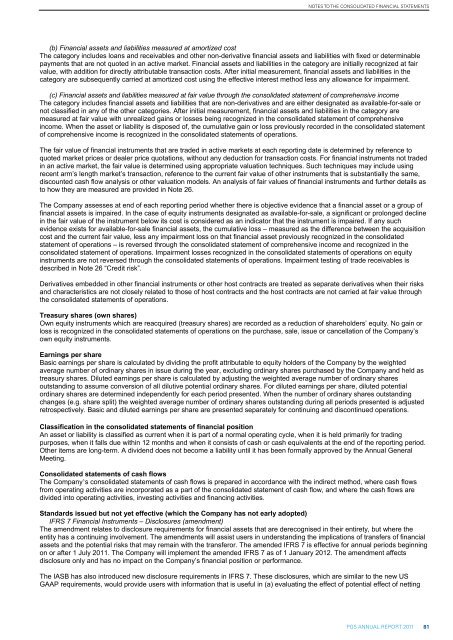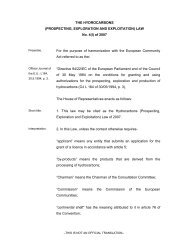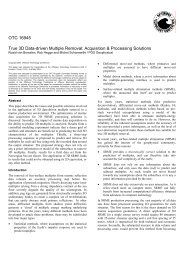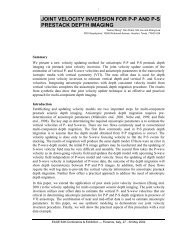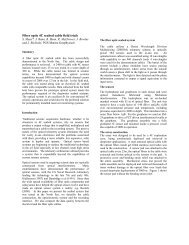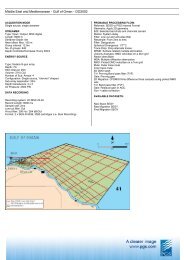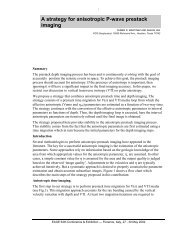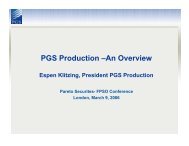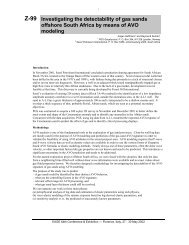Annual Report 2011 - PGS
Annual Report 2011 - PGS
Annual Report 2011 - PGS
You also want an ePaper? Increase the reach of your titles
YUMPU automatically turns print PDFs into web optimized ePapers that Google loves.
Notes to the consolidated financial statements<br />
NOTES TO THE CONSOLIDATED FINANCIAL STATEMENTS<br />
(b) Financial assets and liabilities measured at amortized cost<br />
The category includes loans and receivables and other non-derivative financial assets and liabilities with fixed or determinable<br />
payments that are not quoted in an active market. Financial assets and liabilities in the category are initially recognized at fair<br />
value, with addition for directly attributable transaction costs. After initial measurement, financial assets and liabilities in the<br />
category are subsequently carried at amortized cost using the effective interest method less any allowance for impairment.<br />
(c) Financial assets and liabilities measured at fair value through the consolidated statement of comprehensive income<br />
The category includes financial assets and liabilities that are non-derivatives and are either designated as available-for-sale or<br />
not classified in any of the other categories. After initial measurement, financial assets and liabilities in the category are<br />
measured at fair value with unrealized gains or losses being recognized in the consolidated statement of comprehensive<br />
income. When the asset or liability is disposed of, the cumulative gain or loss previously recorded in the consolidated statement<br />
of comprehensive income is recognized in the consolidated statements of operations.<br />
The fair value of financial instruments that are traded in active markets at each reporting date is determined by reference to<br />
quoted market prices or dealer price quotations, without any deduction for transaction costs. For financial instruments not traded<br />
in an active market, the fair value is determined using appropriate valuation techniques. Such techniques may include using<br />
recent arm’s length market’s transaction, reference to the current fair value of other instruments that is substantially the same,<br />
discounted cash flow analysis or other valuation models. An analysis of fair values of financial instruments and further details as<br />
to how they are measured are provided in Note 26.<br />
The Company assesses at end of each reporting period whether there is objective evidence that a financial asset or a group of<br />
financial assets is impaired. In the case of equity instruments designated as available-for-sale, a significant or prolonged decline<br />
in the fair value of the instrument below its cost is considered as an indicator that the instrument is impaired. If any such<br />
evidence exists for available-for-sale financial assets, the cumulative loss – measured as the difference between the acquisition<br />
cost and the current fair value, less any impairment loss on that financial asset previously recognized in the consolidated<br />
statement of operations – is reversed through the consolidated statement of comprehensive income and recognized in the<br />
consolidated statement of operations. Impairment losses recognized in the consolidated statements of operations on equity<br />
instruments are not reversed through the consolidated statements of operations. Impairment testing of trade receivables is<br />
described in Note 26 “Credit risk”.<br />
Derivatives embedded in other financial instruments or other host contracts are treated as separate derivatives when their risks<br />
and characteristics are not closely related to those of host contracts and the host contracts are not carried at fair value through<br />
the consolidated statements of operations.<br />
Treasury shares (own shares)<br />
Own equity instruments which are reacquired (treasury shares) are recorded as a reduction of shareholders’ equity. No gain or<br />
loss is recognized in the consolidated statements of operations on the purchase, sale, issue or cancellation of the Company’s<br />
own equity instruments.<br />
Earnings per share<br />
Basic earnings per share is calculated by dividing the profit attributable to equity holders of the Company by the weighted<br />
average number of ordinary shares in issue during the year, excluding ordinary shares purchased by the Company and held as<br />
treasury shares. Diluted earnings per share is calculated by adjusting the weighted average number of ordinary shares<br />
outstanding to assume conversion of all dilutive potential ordinary shares. For diluted earnings per share, diluted potential<br />
ordinary shares are determined independently for each period presented. When the number of ordinary shares outstanding<br />
changes (e.g. share split) the weighted average number of ordinary shares outstanding during all periods presented is adjusted<br />
retrospectively. Basic and diluted earnings per share are presented separately for continuing and discontinued operations.<br />
Classification in the consolidated statements of financial position<br />
An asset or liability is classified as current when it is part of a normal operating cycle, when it is held primarily for trading<br />
purposes, when it falls due within 12 months and when it consists of cash or cash equivalents at the end of the reporting period.<br />
Other items are long-term. A dividend does not become a liability until it has been formally approved by the <strong>Annual</strong> General<br />
Meeting.<br />
Consolidated statements of cash flows<br />
The Company’s consolidated statements of cash flows is prepared in accordance with the indirect method, where cash flows<br />
from operating activities are incorporated as a part of the consolidated statement of cash flow, and where the cash flows are<br />
divided into operating activities, investing activities and financing activities.<br />
Standards issued but not yet effective (which the Company has not early adopted)<br />
IFRS 7 Financial Instruments – Disclosures (amendment)<br />
The amendment relates to disclosure requirements for financial assets that are derecognised in their entirety, but where the<br />
entity has a continuing involvement. The amendments will assist users in understanding the implications of transfers of financial<br />
assets and the potential risks that may remain with the transferor. The amended IFRS 7 is effective for annual periods beginning<br />
on or after 1 July <strong>2011</strong>. The Company will implement the amended IFRS 7 as of 1 January 2012. The amendment affects<br />
disclosure only and has no impact on the Company’s financial position or performance.<br />
The IASB has also introduced new disclosure requirements in IFRS 7. These disclosures, which are similar to the new US<br />
GAAP requirements, would provide users with information that is useful in (a) evaluating the effect of potential effect of netting<br />
<strong>PGS</strong> ANNUAL REPORT <strong>2011</strong> 10<br />
<strong>PGS</strong> <strong>Annual</strong> <strong>Report</strong> <strong>2011</strong> 81


